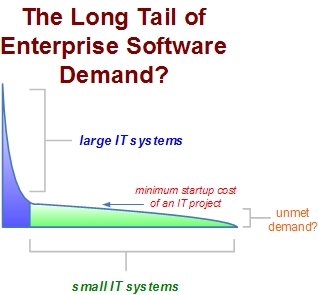Repeating history, The Long Tail, and software demand

Peter Rip of Leapfrog Ventures did a really good take recently on what Web 2.0 will look like in the enterprise. I bring your attention to it Both SaaS and Web 2.0 can be delivered on the Web, but the former tends to provide more function than data, and the latter tends to provide more data than function.because it brings out a few essential points and almost makes a few others I think are still missing in the larger industry conversation about Web 2.0 and its increasing push into the enterprise.
Plenty of people say that Web 2.0 isn't anything new and they get that part almost right. What's old is new again in important ways and Peter observes that if you were in the industry before the PC, that you might actually have an unfair competitive advantage. And that's because you'd be clearly seeing history repeat itself again, twice, says Rip. We seem to be seeing a very similar shift of control to the one that the PC era originally ushered in two decades ago; users are increasingly taking back control over their IT:
Today the Enterprise seems to be The Land That Time Forgot. The IT lock-down of the Enterprise (because of TCO, security, compliance, and the complexity of legacy computing) and the innovation of Web Applications (a.k.a. Web 2.0) have set the stage for a reprise of Users vs. IT just as in the PC revolution. Web Apps are sneaking in through Port 80 just as PCs snuck in the front door twenty years ago, a phenomenon that ultimately wrestled Model, View, and Control from IBM.
Peter categorizes the future of Enterprise Web 2.0 into two broad themes. Big Enterprise Web 2.0, which consists of the integration scenarios made possible by Web 2.0 ways of doing things (like collaboration, WOA, mashups, and integration on the edge) and little Enterprise Web 2.0, which involves more of a software as a service concept of the Google variety (mailing, chat, calendaring, office automation, etc.) that are specifically directed at business use cases. And clearly, no matter what it's called, these things will increasingly become part of the enterprise landscape, and often not through the IT department.
A Real Enterprise Web 2.0 Enabler: Shrinking the I in ROI
But I believe another big trend is that shrinking solution space inside most enterprises means that there are enough big IT systems to cover the largest single part of the software demand. And given how IT is often structured, the startup cost of most software projects involves an analyst, tester, developer, support staff, etc. Given that, almost any IT system is going cost in the hundreds of thousands or low millions even to get off the ground. This means that many smaller, niche demands, which statistically, are very likely to be larger than the demand for big IT systems in an organization (The Long Tail), are actually continuing to go dramaticaly underserved and block access to solutions that could enable local tacit interactions.

This means that unless an IT system can afford to be a loss leader for some reason, a great many automation and tacit interactions scenarios are going untapped due to returns that won't exceed initial investment in any reasonable timeframe. This is where SaaS and Web 2.0 has the potential to help. We can see even now the relentless push out on the Web to dramatically simplify development models in order to attack old problems with radically simpler and cheaper solutions. Witness the push for EJB 3.0, Ruby on Rails, PHP, and many other lighter weight application stacks that make it many times easier in many cases to deliver working software. These are increasingly providing real options to development shops to create much cheaper IT solutions.
So too are we starting to see end user tools that require little or no IT involvement that allow savvy users to combine data from multiple sources (enterprise mashup tools like Kapow), create visual business processes that reuse existing IT assets (example: Bridgewerx), and to create ad hoc collaborative environments (blogs and wikis.)
And this brings us to one last fine point. Self-service IT can be done with either SaaS or Web 2.0. But lest we forget, SaaS and Web 2.0 are overlapping but different concepts. SaaS represents online, hosted software that can be obtained on-demand while Web 2.0 is essentially about enabling collectively built online collections of shared information. SaaS and Web 2.0 can both be delivered on the Web, but the former tends to provide more function than data, and the latter tends to provide more data than function.
History also teaches us that there will be an inevitable industry consolidation and a few very big players will emerge in control of things: the market, the software, the audience, and the information. But this time it might be a little different; the power of the The Long Tail might be set free and make real market dominance no longer possible. We will see.